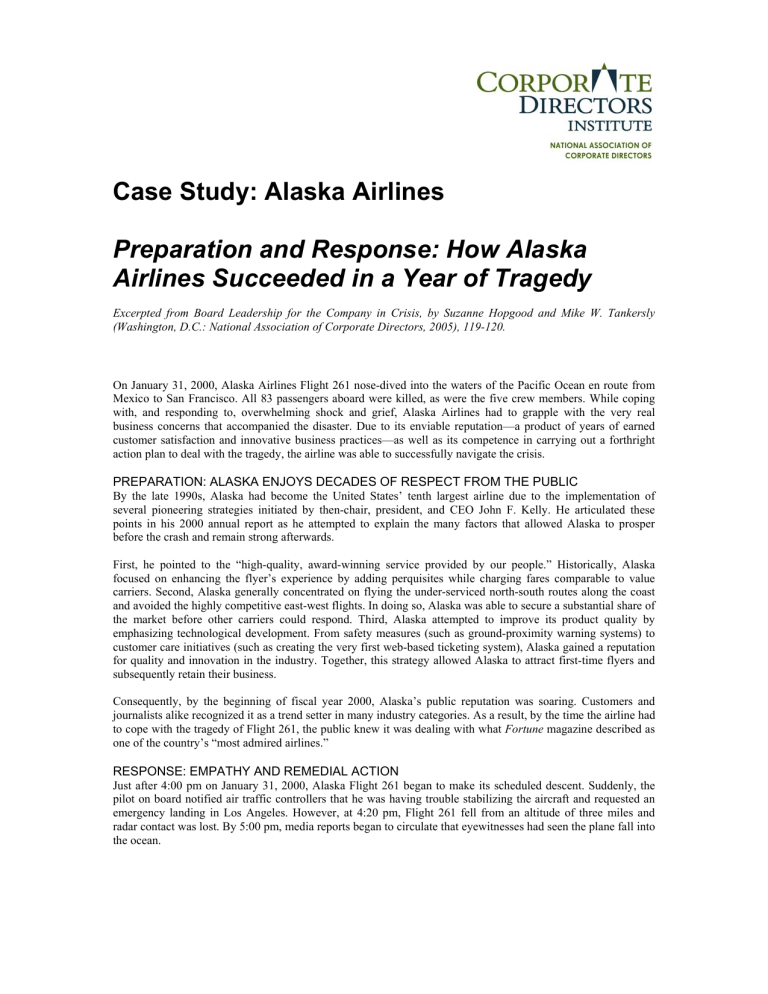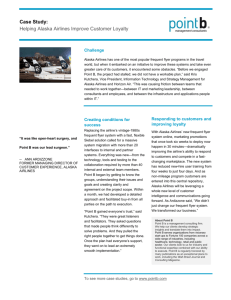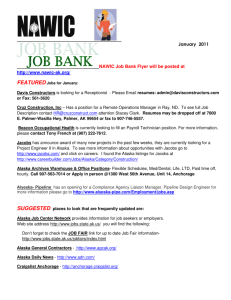Case Study: Alaska Airlines Preparation and Response: How Alaska

Case Study: Alaska Airlines
Preparation and Response: How Alaska
Airlines Succeeded in a Year of Tragedy
Excerpted from Board Leadership for the Company in Crisis, by Suzanne Hopgood and Mike W. Tankersly
(Washington, D.C.: National Association of Corporate Directors, 2005), 119-120.
On January 31, 2000, Alaska Airlines Flight 261 nose-dived into the waters of the Pacific Ocean en route from
Mexico to San Francisco. All 83 passengers aboard were killed, as were the five crew members. While coping with, and responding to, overwhelming shock and grief, Alaska Airlines had to grapple with the very real business concerns that accompanied the disaster. Due to its enviable reputation—a product of years of earned customer satisfaction and innovative business practices—as well as its competence in carrying out a forthright action plan to deal with the tragedy, the airline was able to successfully navigate the crisis.
PREPARATION: ALASKA ENJOYS DECADES OF RESPECT FROM THE PUBLIC
By the late 1990s, Alaska had become the United States’ tenth largest airline due to the implementation of several pioneering strategies initiated by then-chair, president, and CEO John F. Kelly. He articulated these points in his 2000 annual report as he attempted to explain the many factors that allowed Alaska to prosper before the crash and remain strong afterwards.
First, he pointed to the “high-quality, award-winning service provided by our people.” Historically, Alaska focused on enhancing the flyer’s experience by adding perquisites while charging fares comparable to value carriers. Second, Alaska generally concentrated on flying the under-serviced north-south routes along the coast and avoided the highly competitive east-west flights. In doing so, Alaska was able to secure a substantial share of the market before other carriers could respond. Third, Alaska attempted to improve its product quality by emphasizing technological development. From safety measures (such as ground-proximity warning systems) to customer care initiatives (such as creating the very first web-based ticketing system), Alaska gained a reputation for quality and innovation in the industry. Together, this strategy allowed Alaska to attract first-time flyers and subsequently retain their business.
Consequently, by the beginning of fiscal year 2000, Alaska’s public reputation was soaring. Customers and journalists alike recognized it as a trend setter in many industry categories. As a result, by the time the airline had to cope with the tragedy of Flight 261, the public knew it was dealing with what Fortune magazine described as one of the country’s “most admired airlines.”
RESPONSE: EMPATHY AND REMEDIAL ACTION
Just after 4:00 pm on January 31, 2000, Alaska Flight 261 began to make its scheduled descent. Suddenly, the pilot on board notified air traffic controllers that he was having trouble stabilizing the aircraft and requested an emergency landing in Los Angeles. However, at 4:20 pm, Flight 261 fell from an altitude of three miles and radar contact was lost. By 5:00 pm, media reports began to circulate that eyewitnesses had seen the plane fall into the ocean.
Understanding that his plane had unmistakably crashed, and that news stories would likely play to strong emotions, Kelly immediately acted to address, rather than evade, the public’s anxieties. By 5:30, Alaska acknowledged that one of its planes had lost radar contact, and by 6:00, the company announced that the plane had crashed into the Pacific. Immediately, Alaska’s “CARE” team was mobilized to assist the families of the passengers and crew. Throughout the night of the accident, Alaska continually updated its website and held press conferences in order to inform the media and the public of developments. The company provided background information on everything from the history of the specific airplane and the model of the aircraft to Alaska’s sparse history of air disasters, as well as its efforts to console the families of the victims.
In addition, the company’s crisis management efforts lasted long after the initial hours. During the following months, the FAA investigated concerns that Alaska’s maintenance program was cutting corners in several localities and placed the airline under intense examination. Kelly and the board of Alaska did not prevaricate, but faced the charges head-on. The board approved the creation of the position of vice president for safety, and approved the hiring of nearly 200 new maintenance staff and dozens of dedicated safety personnel. Kelly emphasized that this policy was so important that the new VP would report directly to him: “It’s a matter of being able to have a centralized place that now houses all the various safety elements that we had there before.”
Additionally, the board hired a new senior vice president of maintenance and engineering to improve the airline’s deficiencies.
By June 2000, the FAA had approved Alaska’s plan to improve its maintenance procedures. Kelly claimed that
Alaska not only met the government’s requests but exceeded them: “We’re very pleased that the FAA has accepted our plan. ... (We) really tried to go above and beyond what they asked for.”
ACCOLADES FOR ALASKA AIR
With a solid safety record, a reputation for customer satisfaction, and a forthright and empathetic response to the crash, Alaska Airlines was able to endure the inevitable scrutiny that accompanies the loss of an aircraft. The day after the crash, The Washington Post ran a story that noted “Alaska Airlines has an enviable safety record, with only two fatal crashes in its history until Flight 261.” Passenger response was generally positive as well. Alaska boasted a “record-high load factor” during the year following the crash. Also, Alaska’s stock price, which dropped from about $35 per share to $25 after the tragedy, completely rebounded by the one-year anniversary of the crash.
Altogether, Alaska was able to endure the accident because, as Bob Vandel of the Flight Safety Foundation noted, the board was open to the public. He added, "I think that’s a healthy attitude. If there was something wrong they wanted to fix it.” Further, others also believe that the Alaska case demonstrates the best in crisis management practices. Richard K. Long, professor of communications at Brigham Young University stated,
“Alaska Airlines gets far better than passing marks for its handling of a complex and heartrending situation. They have very likely set a new standard for other airlines and industries to meet in trying circumstances.”









